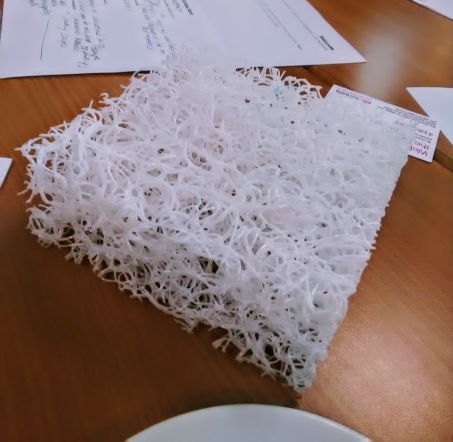…was the title of a conference/workshop on research data management in the creative arts I attended yesterday. We started off with this:

It was one of several “Curious Items” placed on the tables around the room. Our task was to think of a title for the item, describe it, say what it was made from, decide why the object was created (its context) and decide on the purpose of the object (what we can learn from it). We decided to call our object “Mind Mattress”… The purpose of this exercise was to get us to recognise (if we hadn’t already) the difficulty of assigning specific and accurate information to arts and humanities ‘objects’ – unlike in science, we are not dealing in facts, but in ideas, emotions, concepts, and other ambiguous, unquantifiable things. This was followed by a presentation by Leigh Garrett, Director of the Centre for Digital Scholarship, Library and Student Services at the University for the Creative Arts (UCA) on “Stuff and data: an introduction to research data management in the creative arts”, during which we had to answer questions:
- What is research data in the creative arts?
- Why do we want to manage research data in the creative arts?
- What do we need to consider?
Answers to these questions (and more) can be found at in Leigh et al’s article on ARIADNE. I will add links to the presentations from the day once they are sent out.
Next, we heard from Amanda Couch, a lecturer and artist from UCA. She works with food, in particular offal. She shared various aspects of her research (and her research data) – a case study. I found her comparison of Instagram to a ‘cabinet of curiosities’ (or Wunderkammer) very interesting, as well as the use of Instagram as a way of capturing research data (as someone who is dyslexic and dyspraxic Amanda has found this visual/’wordless’ way of data collection very useful as a way of making a record of her practice).

We then moved on to look at “Arts data management in the real world”; two case studies of the use of arts research data. The first was Glasgow School of Art – Dr Robyne Calvert and Nicola Siminson talked about their experiences of implementing research data management and how research data became essential to the rebuilding of the Mackintosh Building following the devastating fire in 2014.
The next case study was about engaging arts researchers with EPrints research repositories, presented by Stephanie Meece (UAL) and Amy Robinson (UCA). They talked about the Kultur project; the aim of which was
to create a transferable and sustainable institutional repository model for research output in the creative and applied arts…
This meant making quite a few changes to the standard EPrints ‘look and feel’ to make it more ‘arts friendly’. For example there is a much improved and increased use of images on the sites created for UCA and UAL; language has been changed to better reflect that used in the creative arts; there are different item types and sub-types available as options when adding items to the repository. We have (relatively) quite a lot of engagement with creative arts staff/researchers, and I wonder whether there are some simple customisations we could make to our repository in order to make it friendlier and easier to use for these folk (and others).
After lunch (yum), Daniela Duca from JISC spoke about current developments in research data management at JISC. She left us with two questions:(1) What should a next-generation research environment look like? (2) What skills do people need to prepare for research practice now and in the future? Perhaps topics for a future LRS Seminar?
We then had a “repository rodeo”. No horses or bulls were present, alas (or perhaps just as well). Instead, there were short presentations from Figshare, Arkivum and Artivity – all of which you can have a look at online instead of me fruitlessly writing about what was said.
We then split into groups again to think about the future of research data in the creative arts. I was in the group looking at service development. Only one person on the table was actually currently doing anything with research data management in their institution, and this was not specifically for creative arts research data. It was very interesting to hear about what they are planning/doing and one question that came out of our discussion was is it really a good thing to have a[n institutional] research data repository? which sounds like a weird question to ask in the context, but is actually a good point. There are plenty of places where people can put their research data that are not actually institutional research data repositories (e.g. subject or funder respositories), so do we really need to have our own research data repository? The answer is probably, ‘it depends’!
Finally, we looked again at our “Curious Items” and found out what they actually were. The name of our object was really “Breathair Hollow”, a “breathable polyester cushion substitute for urethene foam that uses a hollow yarn to reduce weight”. So there we are.